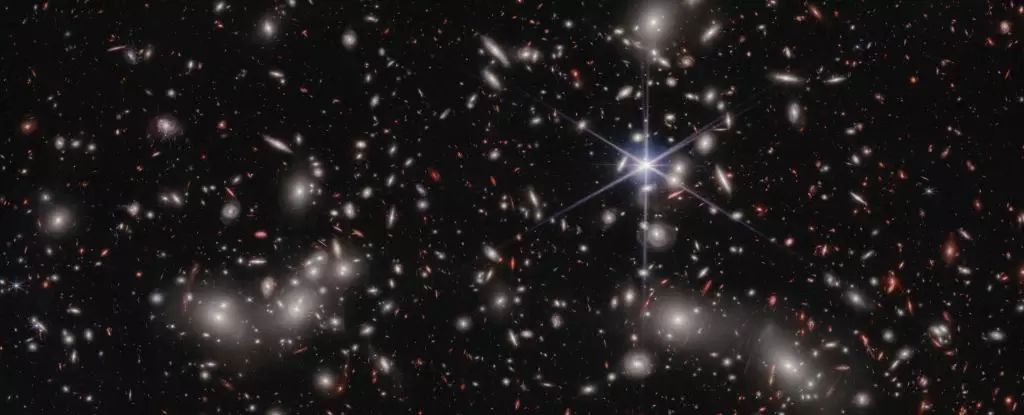The early Universe is often characterized as a dark and formless expanse, filled with a dense fog of ionized plasma. Recent advancements in astronomy, particularly via the Hubble and James Webb Space Telescopes, have shed new light on the origins of the photons that eventually filled this void. The landmark research indicates that small dwarf galaxies played a crucial role in this process, allowing us to understand one of the most enigmatic phases in cosmic history. According to Iryna Chemerynska, an astrophysicist at the Institut d’Astrophysique de Paris, these ultra-faint galaxies were instrumental in the ionization of neutral hydrogen during the epoch known as cosmic reionization, significantly shaping the evolution of the Universe.
To grasp the importance of dwarf galaxies, it is vital to understand the conditions present shortly after the Big Bang. Within minutes of the Universe’s birth, it was filled with a hot, dense plasma—neither light nor visibility could penetrate this murky environment. Approximately 300,000 years post-Big Bang, the Universe began to cool, allowing protons and electrons to combine and form neutral hydrogen gas. However, it was a bleak time for light. Although the newly formed hydrogen was more translucent than the previous ionized plasma, there was a scarcity of luminous sources to illuminate the vast darkness.
The situation began to transform with the formation of the first stars, which produced intense radiation capable of stripping electrons from their atomic nuclei and thus reionizing the surrounding gas. Although this critical process transitioned the Universe from darkness to light, it is essential to highlight that at this stage, due to the expansive nature of the Universe and the dispersion of gas, the light emitted from these stars could not escape easily. The period known as the cosmic dawn, thought to last until about a billion years after the Big Bang, marks the time when the Universe made this significant transition to a reionized state.
Previously, researchers believed that massive black holes and large galaxies undergoing intense star formation were the primary sources behind the clearing of the cosmic haze. The powerful light produced by these structures seemed the most plausible explanation for the Universe’s eventual illumination. However, the latest findings reveal a completely different narrative. An international research team led by Hakim Atek turned their focus to the galaxy cluster Abell 2744, which warps space-time around it, effectively acting as a cosmic lens. This phenomenon allowed scientists to observe faint dwarf galaxies that existed near the era of cosmic dawn.
Through meticulous spectral analysis from JWST, the researchers discovered that dwarfs are the predominant galaxy type of the early Universe—outnumbering larger galaxies by a staggering 100 to 1. More remarkably, the collective energy output from these tiny galaxies was found to be four times greater in terms of ionizing radiation than previously estimated. “These cosmic powerhouses collectively emit more than enough energy to accomplish reionization,” Atek noted, emphasizing the unexpected significance of these low-mass galaxies in cosmic evolution.
While this research provides compelling evidence pointing toward dwarf galaxies as the architects of cosmic illumination, it also leaves room for further exploration. The study focused on a relatively small area of the sky, which raises questions about whether the observed abundance of dwarf galaxies in Abell 2744 is representative of the larger cosmic landscape. To validate their findings, the research team plans to investigate additional lensing regions throughout the cosmos, seeking a broader understanding of early galactic populations.
This quest for more comprehensive data is crucial; uncovering more dwarf galaxies and quantifying their influence will not only confirm their role in reionization but also enhance our understanding of the evolving structure of the cosmos itself.
The ramifications of these discoveries are profound. For years, physicists and astronomers have grappled with the elusive concepts surrounding cosmic reionization, and the recent insights offer a glimmer of clarity in what has been a thick fog of uncertainty. The entry of sophisticated instruments like the JWST into this field has opened new frontiers, enabling us to probe depths of cosmic history that were previously inaccessible.
As researchers continue their investigations into the early Universe, one thing is abundantly clear: dwarf galaxies, small yet mighty, are rewriting the narrative of cosmic evolution. With every new observation, we venture deeper into the unknown, slowly illuminating the darkest corners of our Universe’s past. As Themiya Nanayakkara of Swinburne University of Technology poignantly states, “We have now entered uncharted territory with the JWST.” The insights gleaned thus far herald an exciting future in our quest for knowledge about the genesis of the cosmos.

